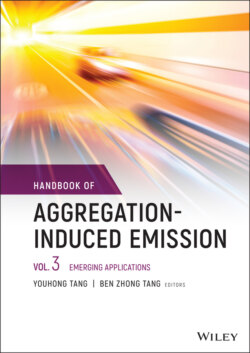Читать книгу Handbook of Aggregation-Induced Emission, Volume 3 - Группа авторов - Страница 24
1.4 Conclusion and Outlook
ОглавлениеOLED technology has experienced a rapid progress in last few decades, and numerous emitters of various structures with different photophysical mechanisms have been applied to this area. Due to OLEDs’ nature of solid‐state lightening, the emitters’ aggregated states also play a vital role in the performance of OLEDs, especially for the efficiency and luminance. The ACQ properties have the drawbacks of quenching and lowering the EQE of OLEDs; therefore, in order to overcome ACQ behaviors, the doping technology was often resorted to, causing complex process and unstable performance for the devices. In contrast to ACQ, AIE property means that emitters have increased emission in aggregated states, enabling them to prepare nondoped OLED devices, still with high efficiency and luminance. Till now, numerous AIE emitters have been applied in OLED devices; therefore, in this review, we mainly demonstrated the emitters based on AIE integrated with different photophysical mechanisms and their applications in OLED devices. So far, most of AIE emitters are traditional fluorescent. Due to the facile molecule design, the traditional fluorescent AIE emitters have covered wide range of spectrum, and blue to green from red. And even a lot of white OLEDs based on these emitters have been fabricated. However, due to the theoretic EQE limitation of 5% for traditional AIE emitter‐based OLED, AIE property has been combined with other high EUE photophysical mechanisms to prepare highly efficient OLED emitters. Among these emitters, the AIPE emitters with both AIE property and phosphorescent emission were developed first, but with only little progress regarding the emitters reported and the related EQE achieved. The AIDF and HLCT‐AIE materials started quite recently, but with both numerous emitters and high EQE efficiency reported in comparison to their nonAIE‐active counterparts.
Increasing the efficiency of OLED devices is a complex and integrated challenge in the long term. As for the EMLs, they might have multiple photophysical mechanisms coexisting in the emitters both at the molecular levels and in the aggregated state, therefore the strategic design for the emitters was highly required. Apart from the influence of emitters, many other factors also play significant roles in determining the efficiency of OLED devices such as processing methods, doping, and lighting‐extraction. When it comes to the application of emitters from the laboratory to commercial, these factors, including cost, stability, and lifetime of the device cannot be ignored. From these points, AIE emitters have already been applied in nondoped OLEDs with evident advantages of high efficiency, low cost, and high stability. In spite of these achievement, there is still enough room for developing AIE emitters in OLEDs, such as improving the efficiency of OLEDs or designing novel AIE emitters with other high EUE mechanism of triplet–triplet annihilation (TTA) [130, 131], triplet exciton‐polaron annihilation (TPA) [33], or singlet fission [132]. Finally, we hope that OLED devices will profit more from AIE emitters both academically and commercially in the future.
